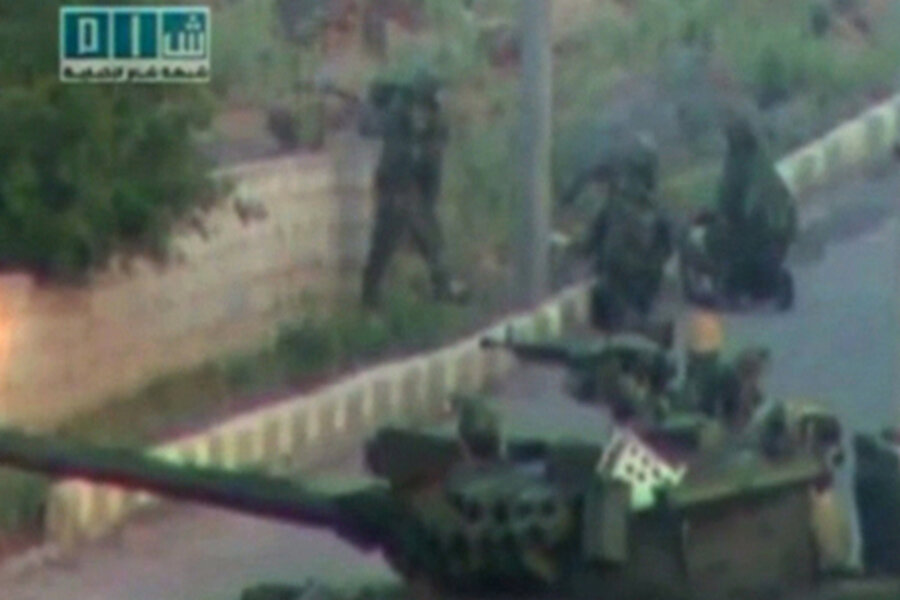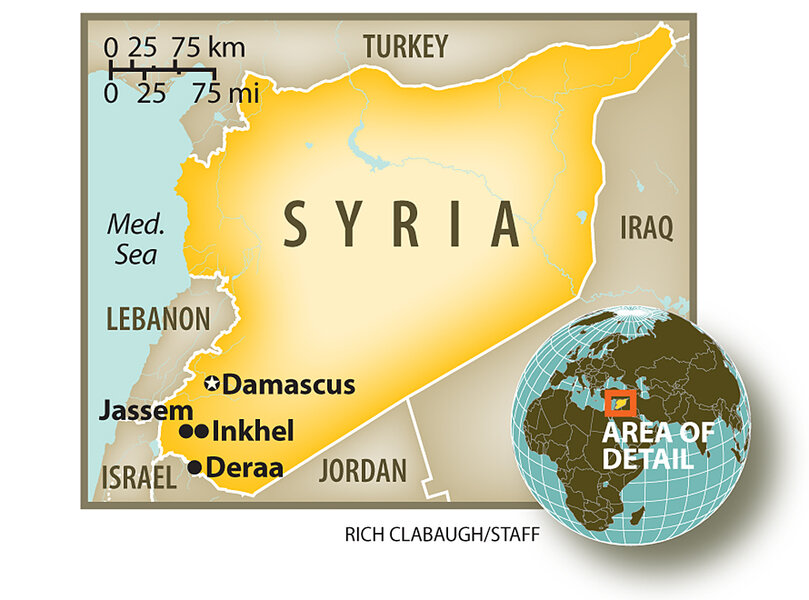Syria's military shows signs of division amid crackdown
Loading...
| Beirut, Lebanon
Cracks may be emerging in Syria's military as more soldiers appear to be taking a stand against firing on protesters six weeks into the popular uprising against President Bashar al-Assad.
Syrian security forces launched an offensive against several flashpoint towns at dawn today, closing the border with Jordan and using tanks and live ammunition to clear streets and arrest suspected protesters, according to opposition activists and eyewitnesses. But Syrian military units reportedly clashed with each other in Deraa when soldiers refused to open fire.
The report follows numerous other refusals as well as a spate of assassinations of military officials said to be sympathetic to the protesters, according to opposition activists.
Any split that emerges in the Army, which together with the intelligence services forms the state's principle means of enforcing its will, would present an unprecedented challenge to the Assad regime's four-decade rule and cast serious doubt on its ability to survive.
Today's intensified crackdown came after the worst protest violence yet witnessed, with more than 120 people killed since Friday. The sudden surge of casualties appears to have spurred the United States into considering sanctions against Syrian officials, The Wall Street Journal reported Monday.
The report comes a day after Human Rights Watch called for sanctions against Syrian officials found responsible for using violence to suppress the anti-regime protests that have swept the country since mid-March.
Showdown in Deraa
At dawn today, as many as 3,000 Syrian troops backed by armored vehicles entered the southern town of Deraa, where the uprising first took root, and opened fire, killing anywhere between five and 20 people, according to various eyewitness accounts. The border with Jordan, which lies just 2.5 miles south west of Deraa, was closed and telephone lines and electricity in the area around the town were cut.
According to opposition activists, the troops belonged to the elite Fourth Division, which is headed by Maher al-Assad, the brother of the Syrian president.
Eight tanks were deployed in the old quarter of the town. Several bodies lay uncollected in the streets because of the presence of soldiers and bursts of gunfire.
A witness in Deraa told Reuters that snipers positioned on government buildings were shooting at people.
A video clip uploaded to YouTube shows a Syrian T-72 tank grinding down a road and over a makeshift barricade as young men look on.
“Let the world know that Bashar al-Assad is attacking Deraa with tanks,” a male voice says on the clip.
Another witness quoted by Reuters said, “People are taking cover in homes. I could see two bodies near the mosque and no one was able to go out and drag them away.”
There were reports of Syrian troops moving into towns near Deraa including Nuwaima, Jassem, and Inkhel, which also have seen protests. The Shaam News Network, an opposition Facebook page, claimed that there were “dozens of martyrs” in Nuwaima. The claim could not be verified.
The Syrian Flash News Page on Facebook said that “the raiding forces are shooting at everything that is moving and banned ambulances from moving towards the victims.”
Four military officers assassinated
The Arabic Al-Jazeera news channel reported that some soldiers were objecting to firing on civilians and that clashes had broken out between separate Army units in Deraa. The minority Alawite sect – a Shiite offshoot – forms the backbone of the regime and controls the Army and intelligence apparatus in Syria, but the Army’s ranks are mainly composed of Sunnis.
It has been widely speculated that if troops are ordered to use increasing force against civilian protesters, cracks may emerge – possibly along sectarian lines – within the military which could have far-reaching consequences for the durability of the regime.
Sign up for our daily World Editor's Picks newsletter. The best stories, in your inbox.
In the early stages of the uprising in Deraa, a soldier from the Sunni city of Homs was allegedly shot dead for refusing to open fire on protesters. Since then, there have been numerous unverified reports of soldiers and even senior officers being shot for refusing to obey orders.
Last week, Gen. Abdo Khodr Tellawi from Homs was killed with his two sons and a nephew. The Syrian state-run SANA news agency claimed that “armed criminal gangs … killed them in cold blood.” But opposition activists say that the Syrian intelligence services executed them because they were showing signs of sympathy for the protesters.
Other officers killed in the past two weeks include two Christian colonels, Samir Kashour and Whaib Issa, and Gen. Ayad Harfoush, who, like Tellawi, was an Alawite.
Alawite military and intelligence officers are generally expected to stand with the regime, fearing a bloody backlash against them should Assad fall. But the Alawite community is not a homogenous entity and there are longstanding tensions between rival clans which could witness some powerful Alawite figures siding with the opposition against the Assads.
Leaked Syria document approves the killing of army officers
Radwan Ziadeh, the director of the Damascus Center for Human Rights Studies, blamed the killings on the Air Force Intelligence directorate, which spearheaded the crackdown 30 years ago on the Muslim Brotherhood and is generally considered the most powerful intelligence agency in Syria.
Mr. Ziadeh said the regime's blaming “armed gangs” for the spate of assassinations of military officers was in line with the recommendations of a document obtained by opposition activists last week that purports to be written by the Syrian General Intelligence department. The document, dated March 23, when the protests were just beginning, lists propaganda, security, and political measures to be adopted by the security forces. The validity of the document could not be confirmed.
The document said, “It is acceptable to shoot some of the security agents or army officers in order to further deceive the enemy, which will further help the situation by provoking the animosity of the army against the protesters.”
“These shootings are the second stage of the intelligence document,” says Ziadeh. “Maybe we will soon see the third stage, which was the bombing of churches and mosques to stir up sectarian tensions. The regime’s message is either stability with us, or chaos.”







